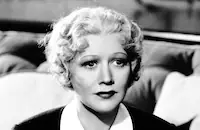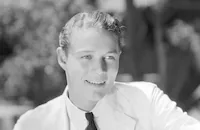Madame X

Brief Synopsis
Cast & Crew
Sam Wood
Gladys George
John Beal
Warren William
Reginald Owen
William Henry
Film Details
Technical Specs

Synopsis
In Paris, Jacqueline Fleuriot regrets her recent affair with Jean Rochin and tells him she is breaking it off, but as she is about to leave his apartment, his jealous girl friend Annette breaks in and shoots him to death while Jacqueline is hiding on the balcony. Because the shots have attracted neighbors, Jacqueline runs away. That same night, her husband Bernard, a famous attorney, comes home to find her out for the evening and their son Raymond ill with a high fever. Bernard knows she is having an affair and confronts her when she returns, forcing her to leave their house at once, without seeing little Raymond, whom she has just learned has become ill. Ten days later, after Raymond has passed the crisis, Jacqueline returns secretly to see Raymond, but Bernard finds her and orders her out again. She only agrees when Bernard threatens to drag the facts of her infidelity through the courts, something which she knows will hurt the child. Weeks later, Maurice Doural, their close friend, convinces Bernard that he has been wrong and they attempt to find her, but she eludes the pursuit. After working as a governess called Miss Pran, Jacqueline sails to America with wealthy Hugh Fariman, Sr., but when they arrive in New York, she finds that he is married and leaves. Haunted by the past and visions of her son, she begins to drink and gradually sells all her jewels and even clothes to get by. In New Orleans, she gets a job singing for Scipio, the owner of a cheap dive, but is fired and again wanders for many years until she meets the cardsharp Lerocle in a South American hotel. Lerocle, who wants Jacqueline to front for him, learns her secret when she rambles about the past while drunk. Meanwhile, Raymond has grown into a young man, become an attorney and is happily engaged to Helene, a wealthy girl. Lerocle travels to France with Jacqueline, who soon realizes that he intends to blackmail Bernard. Desperate to stop Lerocle from hurting Bernard and Raymond, she kills him. By coincidence, Raymond is appointed her attorney, but is unable to learn anything from her, even her name. During her trial, Bernard recognizes her, but before he can say anything, she interrupts and in a veiled way before the court she lets Bernard know that she does not want Raymond to know that she is alive and does not want to be saved. When she realizes that Raymond is her defense attorney, she gently touches his hand as he pleads her case by indicting the unnamed husband whose harsh verdict caused her downfall. While her case is deliberated, Jacqueline collapes and dies, taking her secret with her, but happy in the knowledge that Raymond grew into a fine young man. After her death, Raymond tells his father, "she was a wonderful woman--whoever she was."

Director

Sam Wood
Cast

Gladys George

John Beal

Warren William

Reginald Owen

William Henry

Henry Daniell

Phillip Reed

Lynne Carver
Emma Dunn

Ruth Hussey
Luis Alberni

George Zucco

Cora Witherspoon

Jonathan Hale
Adia Kuznetzoff

Dickie Moore

Edward Keene
Sam Ash
Torben Meyer
Stanley Andrews

Gene Reynolds
Paul Porcasi

Don Douglas
Helen Freeman
Gene Perry
Robert Middlemass
Arthur Blake
Edward Gargan
Bill Bradley
Henry Taylor
Francesco Maran
Clarence Harvey
Christina Montt
Major Farrell
Lowden Adams
Harvey Clarke
Joseph E. Bernard
Charles Waldron
Louis Labey

Leonard Mudie
Barry Downing
Jacques Vanaire
Max Lucke
Ronnie Cosbey
Anita Camargo
Viola Louie
Leila Esparza
Helen Gierre
Art Dupuis
Nick Deruiz
Frank Hagney
Chris Frank
Belle Mitchell

E. Allyn Warren
Fredrik Vogeding
Hal Le Suer
Mahlon Hamilton
J. H. Peters
Olga Borget
Katherine Sabichi
Ferdinand Schumann-heink
Crew
Tom Andre
Walter Donaldson
Chet Forrest
Cedric Gibbons
John Hoffman
Frank E. Hull
Urie Mccleary
James Kevin Mcguinness
John Meehan
John Seitz
Douglas Shearer
David Snell
Edwin B. Willis
Sam Wood
Bob Wright
Z. Yaconelli

Videos
Movie Clip




Trailer
Film Details
Technical Specs

Articles
Madame X (1937)
Alexander Bisson's sentimental tearjerker was made into a movie six times between 1915 and 1966. In 1937 some already saw the story as outdated. Variety stated, "Time has dulled the poignancy of Jacqueline Fleuriot's sin, suffering, grief, and sacrifice." By the 1960s, moral values had changed dramatically and the story needed to be considerably reworked. Writer Jean Holloway was given the task of updating the story for actress Lana Turner. Holloway found the job difficult, "In studying the original play, I discovered that all I could really use from it was the basic premise the woman loving her husband and child, making a mistake, and sacrificing herself to protect them."
Madame X director Sam Wood got his start as an assistant to Cecil B. DeMille in 1915, but by the 1920s he was directing Gloria Swanson films for Paramount. In the 1930s Wood illustrated his versatility directing both the Marx Brothers comedy A Night at the Opera (1935) and the drama Goodbye Mr. Chips (1939), for which he received an Academy Award nomination.
Director: Sam Wood
Producer: James Kevin McGuinness
Screenplay: John Meehan, based on play by Alexandre Bisson.
Cinematography: John F. Seitz
Art Direction: Cedric Gibbons, Urie McCleary, Edwin B. Willis
Music: David Snell
Cast: Gladys George (Jacqueline Fleuriot), John Beal (Raymond Fleuriot), Warren William (Bernard Fleuriot), Reginald Owen (Maurice Dourel), William Henry (Hugh Fairman, Jr.), Henry Daniell (LeRocle), Ruth Hussey (Annette).
BW-72m.
by Deborah Looney

Madame X (1937)
Quotes
Trivia
The play originally opened in Paris, France, on 15 December 1908. An English translation of the play by John Raphael opened in New York City, New York, USA on 2 January 1910 and had 125 performances.
Notes
Alexander Bisson's play, which was translated into English by John Raphael, first appeared in New York on February 2, 1910. According to news items in Hollywood Reporter on 12 and February 13, 1937, Frank Borzage had just left Warner Bros. to work for M-G-M, and Madame X was to be his first directing assignment at his new studio. According to a June 1, 1937 news item in Hollywood Reporter, Twentieth Century-Fox star Tyrone Power was wanted by M-G-M to play the role of "Raymond Fleuriot." By terms of the proposed deal, Fox was to loan Power to M-G-M in exchange for borrowing M-G-M star Jean Harlow for Fox's production of In Old Chicago. Harlow died on June 7, 1937, thus the exchange became impossible and John Beal was cast in the role of Raymond.
A July 3, 1937 Hollywood Reporter news item noted that Sam Wood was replacing Czechoslovakian director Gustav Machaty on the film. Machaty, who apparently replaced Borzage as the picture's intended director some time in the spring, did not direct his first American feature film until 1939's Within the Law (see below), although he worked in various capacities on The Good Earth and possibly other M-G-M films in 1937 and 1938.
According to a Hollywood Reporter news item, Ruth Hussey was to be billed as Ruth March, a stage name recently selected by M-G-M for her, but this was not the case. Although Hussey's screen debut was in a bit role in M-G-M's Big City released in September 1937, Madame X marked her first onscreen billing and the first picture made under contract to M-G-M, a studio for which she worked into the early 1940s.
Madame X has been filmed many times, the most prominent versions of which were the 1920 Goldwyn film directed by Frank Lloyd, starring Pauline Frederick (see AFI Catalog of Feature Films, 1911-20; F1.2710), the 1929 M-G-M version directed by Lionel Barrymore, starring Ruth Chatterton (see AFI Catalog of Feature Films, 1921-30; F2.3328), and the 1966 Universal film, directed by David Lowell Rich and starring Lana Turner (see AFI Catalog of Feature Films, 1961-70; F6.2978).















